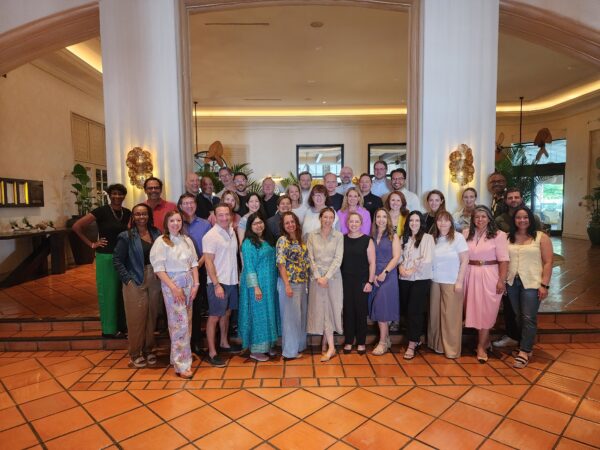Written by Alexandra Mayhew
Embracing the Shift: Why This Moment Matters
There are rare moments in global affairs when the world shifts on its axis – not necessarily abruptly, but unmistakably. One of those moments is happening now. As trade flows shift, geopolitical priorities reorder, and consumer behavior evolves, communicators are being asked to do more than interpret the world. We are being asked to help forecast and shape it with an effective plan for communication strategy. At this hinge moment, the creation of new strategies and plans is essential to ensure organizations can adapt and thrive.

This was the clear throughline of a recent webinar I was part of: Comms In Question – The hinge moment–new markets in a reimagined global economy, hosted by Curious Public and moderated by journalist Steve Paikin. Alongside Iain Nairn, Paul Fogolin, and Lloyd Rang, I explored how countries and businesses are navigating this “hinge moment” to redefine their approach to growth and international market expansion.
In the present environment, understanding current dynamics is crucial for tailoring communication strategies that are relevant and impactful.
At the heart of this transformation is one critical realization: the way we communicate change is just as important as the change itself. In my opinion, a communication strategy has always been essential, but what sets a strong one apart today is how well it’s informed. Strategies grounded in research, real-world data, and diverse perspectives are what make the difference between just having a plan and having impact.
And if you’d like to watch the webinar, you’ll find it here.
Communications as a Strategic Lever for Expansion
During the discussion, I referenced my earlier piece, PR Trends: How Agencies Are Adapting to Market Uncertainty, which outlined how agencies are responding to change – not just in their own markets, but in relation to broader global shifts. In Europe, infrastructure and defence investments are fueling growth, while evolving trade relationships with Asia are opening up new business opportunities. That’s not about Asia investing in defence, it’s about European firms adjusting their focus as the economic and political climate in the US becomes more uncertain. At the same time, APAC agencies are leaning into local market growth, with social and influencer-led strategies gaining pace. Together, these shifts highlight the need for regionally grounded strategies. As confidence in US leadership and markets wavers, agencies are recalibrating where and how they pursue growth.
Success in new markets requires far more than translation; it requires cultural fluency, local insight, and strategic empathy. Well-structured communication plans can help organizations clearly define their objectives, identify their target audience, and tailor key messages that resonate with audiences across diverse communications channels such as social media, , digital, and traditional. Selecting the right channel for distributing information to specific audiences is essential to maximize impact and engagement. Crafting the right message and targeting specific audiences through appropriate channels improves engagement and ensures relevance.
Communications teams are not simply supporting international expansion, but helping define how that expansion is understood and received. The best communicators bridge the gap between local realities and global ambitions, helping organizations shift from market entry to meaningful, lasting presence. This process demands thoughtful communication tactics, a deep understanding of both internal and external audiences, and an awareness of the needs of different customers. Communication strategies must adapt to various customer segments, ensuring that each message is relevant and effective for enterprise, small business, or other defined groups.

That’s the kind of work IPREX does every day. With more than 1,100 professionals in over 100 markets, our partners don’t parachute in; they live and work in the communities where our clients are growing. Many communications professionals are part of these networks, creating impactful communication campaigns that drive customer satisfaction and better engagement. I shared examples of how this approach leads to communication strategies that don’t just travel, they resonate. The value lies in context, in relationships, and in leveraging knowledge within the organization to inform communication strategies and build relevance from the ground up.
Leadership in a Moment of Transition

As Steve Paikin observed, the challenge for leaders today is not certainty, it’s adaptability. Leadership in this “hinge moment” is about asking better questions, listening deeply, and making decisions that are both principled and pragmatic. It is also crucial for leaders and executives to remain connected across the organization to ensure unified communication and alignment of messaging.
I echoed this sentiment, adding that communications leaders and executives have a responsibility to foster shared meaning in uncertain times by reviewing and supporting communication strategies and work. That means creating space for dialogue, recognizing emotion as a business driver, and being courageous enough to challenge outdated narratives. Great leaders understand the influence of effective internal communications and the need to connect with their employees through clear, timely, and relevant messages, with management actively involved in aligning communication efforts.
This kind of leadership is not loud. It’s intentional. It invites collaboration. It inspires trust. Managers also play a key role by collecting feedback from employees to support effective communication and maintain engagement.
What Expansion Requires: Key Learnings from the Panel
Local Insight is Non-Negotiable
Entering new markets without understanding local political, cultural, and social dynamics is a recipe for failure. Panelists stressed the importance of listening to communities before speaking to them. Local insights should guide messaging, positioning, and even product development. A communication effort – meaning specific initiatives aimed at engaging local stakeholders – that lacks this step can miss the mark entirely, and the effort required to ensure communication is effective in new markets should not be underestimated.
Trust is the New Global Currency
As companies expand, trust becomes their most valuable asset. It’s built not just by saying the right things, but by doing them consistently over time.
Trust also comes from transparency, especially when entering sensitive markets. Companies need to be honest about their goals, their practices, and their values and make sure internal communication keeps employees aligned with these principles. Regularly evaluating the company’s communications helps ensure they remain aligned with core values and meet stakeholder expectations.
Diversity Signals Credibility
I emphasised that effective global communication requires diverse perspectives, not just in messaging, but in the teams creating it. Representation shapes understanding. It influences how messages land and whether they are trusted. Communication campaigns grounded in inclusivity often achieve stronger results.
In many markets, representation isn’t just a value statement; it’s a credibility marker. Audiences, especially younger ones, expect brands to reflect the diversity of their communities and to approach engagement with authenticity and respect.
Advocacy is a Core Competency
At this “hinge moment”, the expectations placed on organizations are multiplying, especially for those working beyond their borders. It’s no longer enough for businesses to operate responsibly; they are expected to take a stand. From climate commitments to social justice, public health to digital ethics, the call for advocacy is loud and persistent, and it’s shaping how organisations are perceived across markets.
Communications leaders are actively shaping how social impact is understood and delivered. Employees, in particular, are emerging as some of the most influential advocates inside and outside their organisations. Equipped with the tools of communication, they’re championing causes, shifting narratives, and embedding impact into the everyday. This is no longer niche or optional. Communicators must now understand how to navigate competing expectations, deploy social impact methodologies effectively, and co-create content that reflects lived experience. Trust, credibility, and long-term success increasingly depend on how well an organisation can listen, respond, and lead with purpose.
Practical Recommendations for Communicators

- Conduct a market readiness audit: Assess whether your organization is truly prepared – culturally, structurally, and ethically – to enter new markets. Careful planning is a critical step in preparing for international expansion. Consider your current strategy document and whether it supports international objectives.
- Build coalitions early: Partner with in-market agencies, local influencers, and civic leaders to shape your approach.
- Invest in cultural immersion: Don’t rely solely on research. Spend time in communities. Hire locally. Lead with empathy.
- Design inclusive campaigns from the start: Representation shouldn’t be retrofitted. It should inform strategy from the ground up. Ensure your communication strategies deliver the right messages to the right audiences.
- Develop a diverse global roadmap: Integrate inclusion into every layer of your operations, not just your messaging. Internal communication services are essential for supporting inclusion and engagement across global teams.
- Advocate with clarity and care: Understand how your brand can influence policy, public sentiment, and institutional behavior, then act with purpose. Effective communication helps define roles and responsibilities across departments like human resources and marketing. Strong internal communication can also reduce employee turnover by fostering engagement and alignment.
A Canadian Case Study in Global Diversification
Canada’s economic history has been largely shaped by its proximity and dependence on the United States. But that era of reliance is ending. Recent figures reveal that Canadian travel to the U.S. is down by up to 20%, while trade has decreased by 6.6%. At the same time, trade with non-U.S. markets has surged by nearly 25%. This isn’t a cyclical trend, it’s a structural pivot.
We all agreed: Canada is realigning its trade, diplomacy, and investment strategies. And with that, communicators are now central to helping Canadian brands and public institutions navigate and explain these new relationships. Communication plans are critical for sharing key messages that resonate globally.
It’s about rethinking who we partner with, how we tell our national story abroad, and what our values communicate to the world. As Canada expands its presence globally, this moment requires a new kind of storytelling, one rooted in authenticity, relevance, and purpose. Generating new ideas through team collaboration and research is essential to support Canada’s global communication strategy. Creating engaging media content and utilizing diverse communication channels will help Canadian companies connect with new audiences.
A Case Study: The Video Game Industry

The panel highlighted Canada’s video game sector as an example of what successful international collaboration can look like. With over 32,000 employees working across borders, Canadian gaming companies have learned how to co-create, co-innovate, and co-communicate.
What sets them apart? According to According to Paul Fogolin, President and CEO, Entertainment Software Association of Canada it’s their ability to:
- Build international teams that reflect their global audiences
- Localize content without losing brand integrity
- Use advocacy to influence global policy around digital rights and trade
Other industries can learn from this model. Creative storytelling, inclusive culture, and strategic advocacy are not luxuries, they’re competitive advantages. When companies define their internal processes clearly, align with employee values, and maintain personal contact with local markets, the results are powerful.
The IPREX Advantage

As global dynamics evolve the role of communicators becomes even more essential. This “hinge moment” is not just a challenge, it’s an invitation. For agencies, brands, and institutions, it’s a chance to lead transformation with strategy, inclusivity, and integrity.
In times of market uncertainty, declining sales, and the pressure to expand into new markets, strategic communication can unlock growth, build trust, and clarify purpose. Whether you’re shaping market narratives, engaging stakeholders, or building internal alignment, IPREX helps organisations navigate these moments with insight, focus, and local expertise.
For IPREX and its member agencies, this is a moment of purpose.
Ready to grow? Contact IPREX to develop your international market expansion strategy with experts who understand the balance of global vision and local precision.

AI tools have been used.



